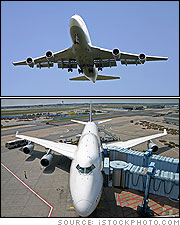Passenger Planes: Boeing 747

They've flown more than 3.5 billion passengers, the equivalent of more than half the world's population
by David Noland
 Boeing 747-100 Specs
Related Links |
When Boeing first announced plans for the 747 "Jumbo Jet" in 1966, it seemed almost too big to fly. Skeptics predicted catastrophic crashes, crumpled runways, and gridlocked passenger terminals.
A Revolutionary Aircraft
But the 747 has become the most famous and successful airliner of all time, a revolutionary aircraft that has reigned unchallenged for 35 years and earned Boeing an estimated $100 billion in sales. That's almost certainly the largest figure for any single industrial product in history.
In the mid-1960s air travel was growing exponentially, spurred by the 1958 introduction of the Boeing 707, the first successful jet airliner. To meet the growing demand, Pan American Airlines president Juan Trippe asked Boeing for a new plane that could carry 400 passengers—twice the 707's capacity. His timing was perfect; Boeing had recently roughed out a jumbo-jet design for the Air Force's C-5 military mega-lifter competition. Although Boeing lost out to Lockheed, it had in hand the technology and design experience to give Trippe the airplane he wanted. In 1966, Pan Am ordered 25 747s at a cost of $550 million.
"The Incredibles"
Boeing launched a massive crash program to design and build the 747. Some 50,000 employees worked with such feverish dedication that Boeing president William Allen dubbed them "The Incredibles." To construct the plane, Boeing built what was then the world's largest building in Everett, Wash. At 200 million cubic feet, it had five times the volume of the Houston Astrodome. Boeing's up-front investment in the 747 totaled more than $1 billion. If the airplane failed, it would take the company down with it.
Boeing rejected a full double-decker design because of potential evacuation problems from the top deck. It settled on a two-aisle ten-abreast main cabin layout, the world's first "wide-body." The 747's visual signature, its unique top-mounted cockpit, was designed so that possible future freighter versions could be loaded through the nose.
The 747's engines were also revolutionary. The Pratt & Whitney JT9D high-bypass turbofans, designed specifically for the 747, were more powerful, fuel-efficient, and quieter than any commercial jet engine ever.
The aircraft that rolled out of the Everett plant in 1968 was gigantic. Nearly as long as a football field, with a tail six stories high, its takeoff weight was almost triple that of the first 707.
The Jumbo Takes Off
Pan Am began 747 service in 1970. (The first flight was seven hours late due to engine trouble, a harbinger of early teething problems.) But the 747 soon silenced the critics by fitting almost seamlessly into the world's airport and terminal systems. Despite initial fears of mass catastrophes, the 747 has achieved an excellent safety record.
By the end of 2005, 1,365 747s had been delivered to 80 different customers. It has flown 3.5 billion passengers, the equivalent of more than half the world's population. The new Airbus A380 will soon bring to an end the 747's reign as the leviathan of the skies. But its title as history's most important airliner is secure.








